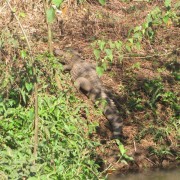Biodiversity
< Back

 Broad-Snouted Caiman
Caiman latirosris | Daudin, 1802
Broad-Snouted Caiman
Caiman latirosris | Daudin, 1802

PHOTO: Property of Native / Embrapa
Characteristics: The animal's back is dark and uniform in color, tending to black. Juveniles are olive-green and have dark spots. This species grows up to 3m in length. Adults weigh 40kg to 70kg and can live up to 50 years. These animals are ectothermic (with temperature varying according to the environment), they like heat, cannot stand the cold, and have good night vision. They have a long tail, useful in the fight for food (against other animals) and for locomotion in water.
Distribution: It is distributed along the coast of South America, northeastern and central Brazil (from Rio Grande do Norte to Rio Grande do Sul), southern Argentina, Uruguay, Paraguay, and eastern Bolivia.
Habitat: Flooded environments, rivers, streams, lagoons, clean and clear perennial lakes, marshes, swamps, and bogs.
Habits: Daytime, crepuscular, nocturnal, terrestrial, aquatic, and can be found alone or in pairs. During the day, they usually stay on the banks of rivers, lakes or ponds, basking in the sun in groups. They hunt at night.
Diet: Carnivore. While juveniles, they feed on invertebrates, and as adults they feed on fish, amphibians, reptiles, birds, and mammals. They control the population of insects and gastropods (snails), which transmit disease such as schistosomiasis.
Breeding: Oviparous. Courting and egg-laying take place in the summer, among females aged more than 7 years and males of over 10 years; eggs hatch 60 to 90 days after laid. After copulation, the male forms a harem. The female builds the nest near water using dried leaves and plant fragments, covering it with leaves and sand.
UFRA: Species commonly spotted in Wetlands with Herbaceous Plants, Wetlands with Riparian Forests and in large bodies of water.












